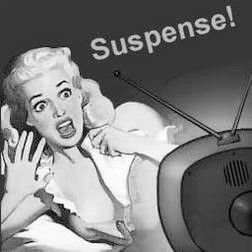
 Suspense (1942-1962) aired “Nobody Loves Me” starring Peter Lorre (1904-1964) on August 30, 1945 as the 156th of its 945 episodes.
Suspense (1942-1962) aired “Nobody Loves Me” starring Peter Lorre (1904-1964) on August 30, 1945 as the 156th of its 945 episodes.
As noted in the introduction to many of the nearly 50 episodes of Suspense presented here over the past ten years (our first since May of 2019 and only the second since October of 2018), it was one of the most well produced, written, acted, and critically acclaimed of all radio shows during the Golden Age of Radio, many a film star jumping at the chance to perform in an episode, among them Cary Grant, Orson Welles, Jimmy Stewart, Susan Hayward, Vincent Price, Charles Laughton, Loretta Young, Peter Lorre, and Rita Hayworth. After many another radio show had gasped its last during the 1950s, Suspense finally closed shop in September of 1962 whereupon radio historians proclaimed the Golden Age of Radio dead, television having become the medium of choice in America.
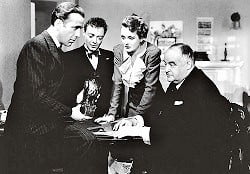 Peter Lorre is probably best remembered at this remove from his life and death (at least in SF/F/H circles) as appearing in, at the end of his career, in several low budget Roger Corman films in the 1960s, sometimes in ensemble casts with Boris Karloff and Vincent Price. Hungarian born, his stage career began in Austria and Germany. He left Germany for the UK when Hitler came to power in the 1930s, and his first English-language picture was 1934’s Alfred Hitchcock directed film The Man Who Knew Too Much. Making his way to the USA and Hollywood some years later, he is known worldwide for a few seminal films while working at Warner Bros. from 1941-46. Among these now classic films was his role as Joel Cairo (his first at Warner) in 1941’s The Maltese Falcon (photo at right, from L to R: Humphrey Bogart, Peter Lorre, Mary Astor, Sydney Greenstreet), the first of what turned out to be nine films with co-star Sydney Greenstreet. In fact, his very next role also featured Greenstreet (and Humphrey Bogart for the second straight time) in another classic film, this time 1942’s iconic WWII
Peter Lorre is probably best remembered at this remove from his life and death (at least in SF/F/H circles) as appearing in, at the end of his career, in several low budget Roger Corman films in the 1960s, sometimes in ensemble casts with Boris Karloff and Vincent Price. Hungarian born, his stage career began in Austria and Germany. He left Germany for the UK when Hitler came to power in the 1930s, and his first English-language picture was 1934’s Alfred Hitchcock directed film The Man Who Knew Too Much. Making his way to the USA and Hollywood some years later, he is known worldwide for a few seminal films while working at Warner Bros. from 1941-46. Among these now classic films was his role as Joel Cairo (his first at Warner) in 1941’s The Maltese Falcon (photo at right, from L to R: Humphrey Bogart, Peter Lorre, Mary Astor, Sydney Greenstreet), the first of what turned out to be nine films with co-star Sydney Greenstreet. In fact, his very next role also featured Greenstreet (and Humphrey Bogart for the second straight time) in another classic film, this time 1942’s iconic WWII 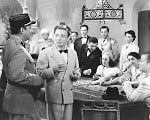 movie Casablanca (photo at left). Lorre would appear in a number of other high profile films during the 1940s and 50s, among them Arsenic and Old Lace (1944), and Disney’s 1954 adaptation of the Jules Verne classic 20,000 Leagues Under the Sea (which also starred Kirk Douglas and James Mason). 1961 saw Lorre as Comm. Lucius Emery in Voyage to the Bottom of the Sea (which would later be turned into a tv series). 1962 saw him in one of the segments from Tales from Terror (“The Black Cat”), and in 1963 as Dr. Adolphus Bedlo in The Raven. This barely scratches the surface, but among the charcteristics and mannerisms that came to be Lorre’s calling cards was his distinctive voice. From The Maltese Falcon and Casablanca to The Raven it was this small (in stature) man’s voice that became his most distinctive asset. So distinctive, I hasten to add, that as youngsters after seeing one of his movies on television, the next day at grade school it was all the rage for some of us to walk the halls between recesses or on the playground or walking to and fro from lunch, to imitate Lorre’s haunting, nasal accent while repeating a few of his most famous lines. And I must confess that after listening to this episode it was like revisiting an old friend, and all that day (when no one was in the house) I was once again that pre-teen youngster imitating Lorre’s mannerisms and voice as best I could. Couldn’t help myself.
movie Casablanca (photo at left). Lorre would appear in a number of other high profile films during the 1940s and 50s, among them Arsenic and Old Lace (1944), and Disney’s 1954 adaptation of the Jules Verne classic 20,000 Leagues Under the Sea (which also starred Kirk Douglas and James Mason). 1961 saw Lorre as Comm. Lucius Emery in Voyage to the Bottom of the Sea (which would later be turned into a tv series). 1962 saw him in one of the segments from Tales from Terror (“The Black Cat”), and in 1963 as Dr. Adolphus Bedlo in The Raven. This barely scratches the surface, but among the charcteristics and mannerisms that came to be Lorre’s calling cards was his distinctive voice. From The Maltese Falcon and Casablanca to The Raven it was this small (in stature) man’s voice that became his most distinctive asset. So distinctive, I hasten to add, that as youngsters after seeing one of his movies on television, the next day at grade school it was all the rage for some of us to walk the halls between recesses or on the playground or walking to and fro from lunch, to imitate Lorre’s haunting, nasal accent while repeating a few of his most famous lines. And I must confess that after listening to this episode it was like revisiting an old friend, and all that day (when no one was in the house) I was once again that pre-teen youngster imitating Lorre’s mannerisms and voice as best I could. Couldn’t help myself.
Of course, Peter Lorre appeared in or hosted quite a few radio shows during the 1940s. Some were just guest appearances on variety or holiday shows starring the likes of Bob Hope, Bing Crosby, or Fred Allen., but in others he played a variety of characters in such shows as Inner Sanctum, Molle Mystery Theater, Nightmare, Suspense, and in 1947 he hosted Mystery in the Air.
Peter Lorre died of a stroke on March 23, 1964 at the too early age of 59. Vincent Price read the eulogy at his funeral.
As to “Nobody Loves Me’,” it is strangely not that dissimilar to the 1931 German film M directed by Fritz Lang, in which Lorre portrayed a serial-killer preying on little girls. According to Lorre’s wikipedia page his performance in the film “caused an international sensation.” So listen now to this depraved, in-your-face story of another psychopath, portrayed as only Peter Lorre can, but with a twist I didn’t see coming.
Play Time: 30:35
{The United States dropped the first atomic bomb on Hiroshima, Japan on August 6, 1945, and three days later on August 9, 1945 a second atomic bomb on Nagasaki, Japan. The Japanese surrendered a few days later on August 15, 1945, effectively ending World War II in the Pacific and World War II overall (the Germans having already surrendered on the European front earlier in the year). So while the parents of the neighborhood gang could talk of nothing else and were preoccupied with the end of the war and our soldiers coming home, it gave the neighorhood gang another excuse to get away unnoticed from the problems of the adult world and visit the nearby newsstand for excitement more to their liking. New Detective (1941-55) actually ran until 1971 by some accounts, but in 1955 it changed its name to True Adventures with an obvious radical change in direction to more “cheesecake” men’s stories. Of note on the cover below is a story by much revered noir crime author Carroll John Daly (1889-1958). Daly is acknowledged as the father of the hard-boiled crime story, the first of which appeared in the December 1922 issue of Black Mask. His private detective Race Williams debuted prior to Dashiell Hammett’s early Continental Op stories, and in the 1940s when Mickey Spillane was raking in the bucks with his Mike Hammer stories, he wrote Daly to acknowledge that Hammer was based on Race Williams. New Detective was a bi-monthly in 1945. Famous Fantastic Mysteries (1939-53) focused on reprints of classic stories before the advent of specific magazines devoted to the SF/F genres and was quite popular for obvious reasons. It was a quarterly in 1945. Weird Tales (1923-54) was the granddaddy of the dark, twisted, or supernatural story, and it drew many of the most revered names in the genre to write for it. Witness the cover names below: August Derleth, Robert Bloch, Ray Bradbury, and Edmond Hamilton. Many of the magazine’s issues now sell for premium prices among collectors. It was a bi-monthly in 1945.}
[Left: New Detective, Sept. 1945 – Center: Famous Fantastic Mysteries, Sept. 1945 – Right: Weird Tales, July 1945]
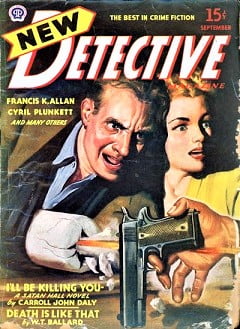
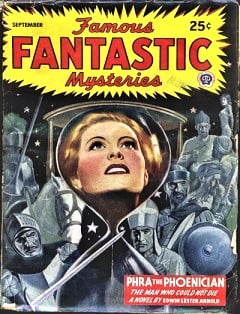
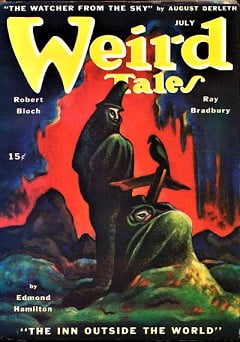
To view the entire list of weekly Old Time Radio episodes at Tangent Online, click here.